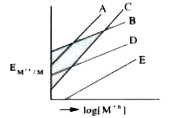The E∘ at 25∘C for the following reaction at the indicated concentrations is 1.50 V . Calculate the ΔG in kJ at 25∘C,Cr(s)+3Ag+(aq.0.1M)→Ag(s)+Cr3+(aq.0.1M)Solution in Telugu
−637
−424
−106
+1.0542V
The correct Answer is:A
ΔG0=−nFE0=−12×96500×0.55=−636.9=−637KJ
Topper's Solved these Questions
- BOOK - AAKASH SERIESCHAPTER - ELECTROCHEMISTRY EXERCISE - PRACTICE SHEET -5 (LINKED COMPREHENSION TYPE QUESTIONS (PASSAGE-I))3videos
ELECTROCHEMISTRY
- BOOK - AAKASH SERIESCHAPTER - ELECTROCHEMISTRY EXERCISE - PRACTICE SHEET -5 (LINKED COMPREHENSION TYPE QUESTIONS (PASSAGE-II))3videos
ELECTROCHEMISTRY
- BOOK - AAKASH SERIESCHAPTER - ELECTROCHEMISTRY EXERCISE - PRACTICE SHEET -4 (INTEGER ANSWER TYPE QUESTIONS )6videos
ELECTROCHEMISTRY
- BOOK - AAKASH SERIESCHAPTER - DILUTE SOLUTIONSEXERCISE - EXERCISE - 1.255videos
DILUTE SOLUTIONS
- BOOK - AAKASH SERIESCHAPTER - ELEMENTS OF D - BLOCKEXERCISE - EXERCISE - 5.233videos
ELEMENTS OF D - BLOCK
Similar Questions
Nernst equation gives the variation of potential of an electrode based on activity of ions temperature and pressure. The equation is
E=E∘−2.303RTnFlogQ(or)E=E∘−0.0591nlogQ
E∘= Standard potential and 'Q' is the reaction quotient.
What is the reduction potential of a hydrogen electrode in an aqueous solution containing 0.1 M NH4OH,(Kb=10−5), ?05:58View SolutionFor metal electrodes show the variation in their reduction potential as shown.

Which is the most reactive metal ?03:06View SolutionDuring electrolysis of one mole or aq HCOOK . How many moles of H2 is formed overall ?
02:00View SolutionWhat are the factor on-which solubility depends on ?
03:15View SolutionGive some examples for the ions with pseudo inert gas electronic configuration.
02:36View SolutionFor the reaction A(aq)⇔B(aq)+2C(aq)KC at 25∘ is 4×10−19 Concentration of B in a solution that had originally C and B concentration of 0.1 M and 0.03 M respectively is :
06:59View SolutionWhat is the approximate value of the equilibrium constant, K_(eq) , at 25^(@) C for the reaction, 3Ag^(+)(aq) + Cr(s) rightarrow Cr^(3+)(aq) + 3Ag(s)
11:05View SolutionThe measured voltage for the reaction with the indicated concentration is 1.50 V. Calculate E∘.
Cr(s)+3Ag+(aq,0.10M)→3Ag(s)+Cr3+(aq,0.30M)05:52View SolutionThe E∘ at 25∘C for the following reaction at the indicated concentrations is 1.50 V. Calculate the ΔG in kJ/mol 25∘C :
03:11View SolutionThe E^(@) at 25^(@) for the following reaction at the indicated concentration is 1.50 V. Calculate the DeltaG in kJ at 25^(@) C: Cr(s)+3Ag^(+)(aq,0.1M) rarrAg(s)+Cr^(3+)(aq,0.1M)
02:51View Solution(a) Calculate ΔG∘ for the following reaction at 25∘C
Au(s)+Ca2+(aq1M)→Au3+(aq1M)+Ca(s)
Given E∘Au3+/Au=+1.50V,E∘Ca2+/Ca=−2.87V
(b) Predict whether the reaction will be spontaneous or not.02:15View SolutionCalculate the standard cell potentials of the galvanic cells in which the following reactions take place. (a) " " 2Cr(s)+3Cd^(2+) to 2Cd^(3+)(aq)+3Cd(s) Given E_(Cr^(3+)//Cr)^(@)=-0.74" V" , E_(Cd^(2+)//Cd)^(@)=-0.40" V" (b) " " Fe^(2+)(aq)+Ag^(+)(aq) to Fe^(3+)(aq)+Ag(s) Gievn E_(Ag^(+)//Ag)^(@)=0.80" V" ,E_(Fe^(3+)//Fe^(2+))^(@)=0.77 " V" Also calculate DeltaG^(@) and equilibrium constant for the reaction.
05:57View SolutionFor the reaction , 2AgCl(s)+H_(2)(g)(1" atm")to2Ag(s)+2H^(+)(0.1 M)+2Cl^(-)(0.1 M),DeltaG^(@)=-43600" J at "25^(@)C . Calculate e.m.f. of the cell.
03:51View SolutionAt 25∘C, the potential (e.m.f) for the cell, Al(s)∣∣Al+3(aq)(0.1M)∣∣∣∣Cd+2(aq)(0.01M)∣∣Cd(s) is :-
02:36View SolutionAt 25^(@)C if the standard enthalpies of formation of MX(s), M^(+)(aq) and X^(-)(aq) are -x, y and -z kJ*mol^(-1) respectively, then what will the heat of reaction be for the reaction M^(+)(aq)+X^(-)(aq)toMX(s) .
04:07View SolutionThe E∘ at 25∘C for the following reaction at the indicated concentrations is 1.50 V . Calculate the ΔG in kJ at 25∘C,Cr(s)+3Ag+(aq.0.1M)→Ag(s)+Cr3+(aq.0.1M)
05:24View Solution

